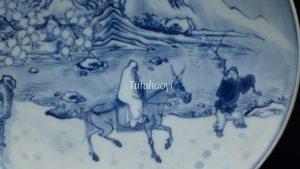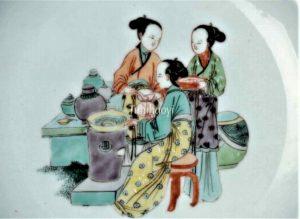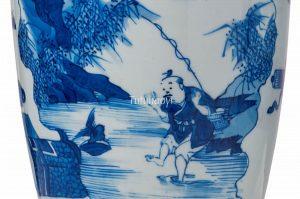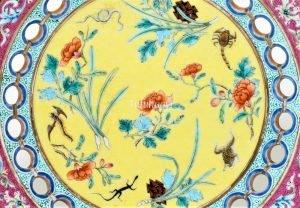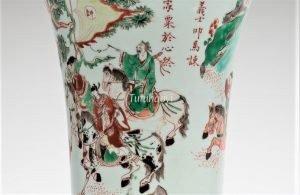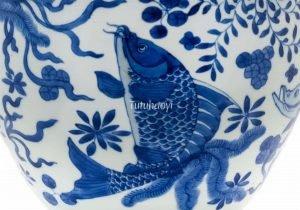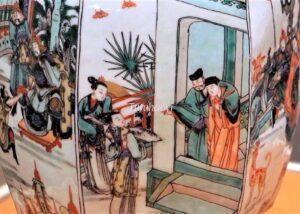Blogs
Interesting findings & case studies on commonly misunderstood and mystery images
A literati theme with the image of a scholar riding in a snowscape with branches of plum blossoms in the vicinity has been very popular in traditional Chinese visual culture and literature. But who is the scholar in the scene? Art historian Dr Yibin Ni hereby unveils the mystery for us.
Pictorial artworks with figural scenes in traditional China often have historical and cultural significance and are not to be mistaken for daily life genre painting. Here is an example and Dr Yibin Ni will explain to you the hidden meaning in the scene of Seasoning the Stew with Sour Prunes.
The Peony Pavilion is a famous play written by Tang Xianzu in Ming Dynasty. There are very few figural paintings depicting this play on Kangxi famille verte porcelain. Dr Yibin Ni first identified the figures and the scene on a porcelain dish in the V&A Museum at the turn of the millennium, and now is discussing a couple of incorrect details in the description of the scene in their online catalogue.
People who are not familiar with Chinese history and parables may have the impression that the above image is a genre painting of fisherman’s daily life. But in fact, there is more meaning to it. Dr Yibin Ni will explain the story in detail and how this story scene has been presented in various forms of artworks.
On Duanwu Festival, Chinese people have a variety of practices, such as drinking rice wine sprayed with realgar powder and hanging images of the Heavenly Master on the lintel. Where did this tradition come from and how were these practices depicted on various artefacts? Here are Dr Yibin Ni’s explanations.
The following article is a discussion of the substitution of a mythical beast for a horse as Grand Duke Jiang’s mount on three classic porcelain vases adorned with the same story scene of ‘Bo Yi and Shu Qi Trying to Stop the Mighty Zhou Army’. It focuses on the origin and evolution of the two disparate but homophonic expressions ‘Sibuxiang’ in late imperial China and clarifies the terminological confusion in the contemporary world.
Through analysing a famous theme that depicts Bo Yi and Shu Qi Stopping the Zhou Army, Dr Yibin Ni has compared a number of porcelain vessels from Ming and Qing dynasties, and demonstrated his unique insight which can facilitate the correct dating of Chinese antiques.
Dr Yibin Ni has discussed the differences of symbolic meanings of lily between Western and Chinese cultures in his unique research, bringing new insight into pictorial art.
Many museums and auction houses are often unaware of the pun rebuses hidden in traditional Chinese pictures and have treated them as mere naturalistic ones. Thus, the cultural and social significance contained in the motifs are unfortunately overlooked. Here is an example of a pun rebus design with four different fishes. What do they actually mean? Please read on…
This is a republication of Dr Yibin Ni’s article written in Chinese “明末清初瓷器上张生的‘凝视’和莺莺的挑战”(Gaze from Scholar Zhang and the response from Lady Cui Yingying: a discussion of figural depiction on porcelains from Late Ming to Early Qing dynasty).
CATEGORIES
RECENT POSTS
 October 03, 2022The ‘Double Yang Day’ in Chinese Traditional Festivals
October 03, 2022The ‘Double Yang Day’ in Chinese Traditional Festivals July 20, 2022Pictorial Presentations of the Story of Cowherd and the Weav ...
July 20, 2022Pictorial Presentations of the Story of Cowherd and the Weav ... June 25, 2022Pictorial Presentation of Amitabha and the Two Assistant Bod ...
June 25, 2022Pictorial Presentation of Amitabha and the Two Assistant Bod ... May 16, 2022Hongwu Porcelain – The Treasure in Ming Dynasty Founded by Z ...
May 16, 2022Hongwu Porcelain – The Treasure in Ming Dynasty Founded by Z ... April 09, 2022How did Guo Ziyi deter the colossal enemy army without fight ...
April 09, 2022How did Guo Ziyi deter the colossal enemy army without fight ...
Archives
- October 2022
- July 2022
- June 2022
- May 2022
- April 2022
- March 2022
- February 2022
- January 2022
- December 2021
- November 2021
- October 2021
- September 2021
- August 2021
- July 2021
- June 2021
- May 2021
- April 2021
- March 2021
- February 2021
- January 2021
- December 2020
- November 2020
- October 2020
- September 2020
- August 2020
- July 2020
- June 2020
- May 2020
- April 2020
